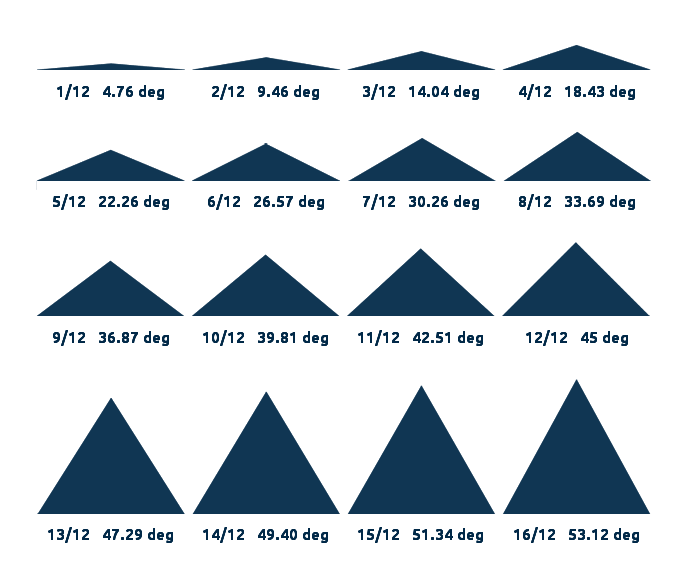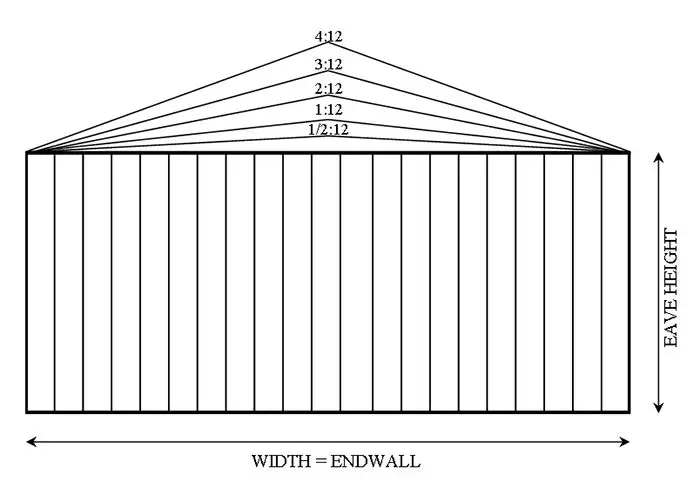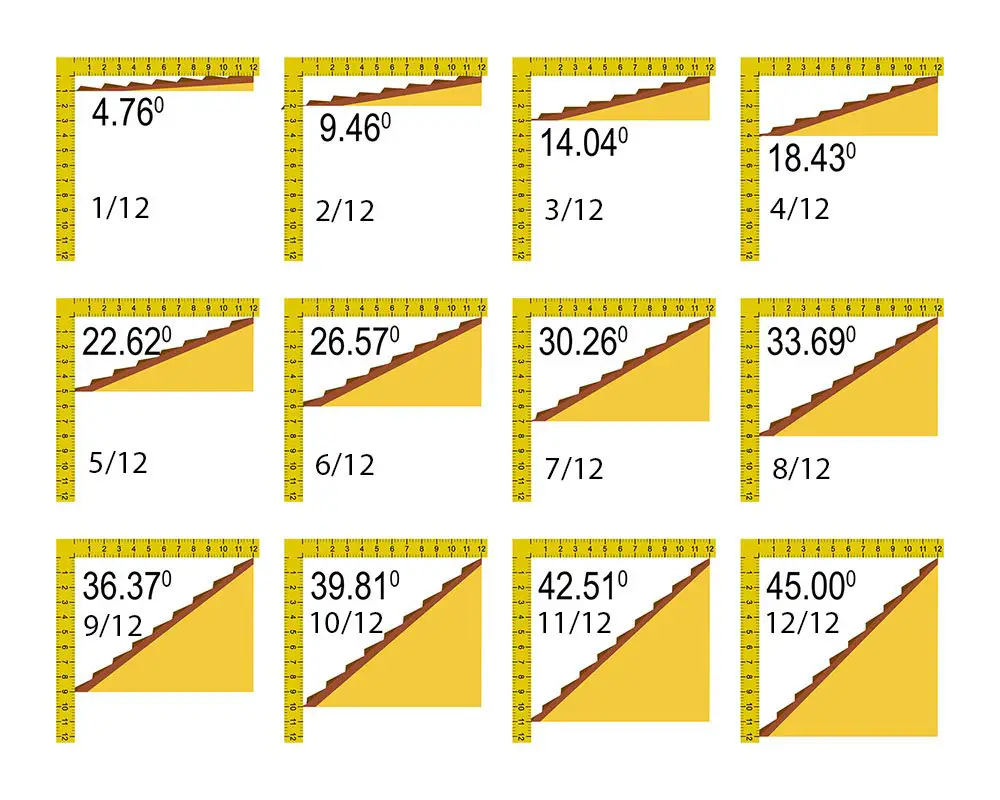What Is The Smallest Pitch Of A Roof
The smallest pitch of a roof is 0.5/12. A completely flat roof is a poor design, as water and snow will collect on it, eventually leading to your roof collapsing in from the weight of it all.
A common choice for flat roofing material is EPDM rubber, as it is highly durable, waterproof, and can be made from recycled materials. Flat roofs also tend to be cheaper and require less maintenance than traditional roofing, making them a perfect addition to your home.
/12 Roof Pitch Rafter Length
Pitch for roof or slope means you how many inches the roof vertical rises for every 12 inches or 1 foot in horizontal distance run. An Example of a pitch for roof would be a 4/12 or 4 in 12 slope means that the roof vertical rises 4 inch for every 1 foot or 12 inches of horizontal distance run.
ALSO READ :-
3/12 roof pitch rafter length | How long is a 3/12 pitch roof
Regarding this how to calculate rafter length for 4/12 roof pitch?, generally 4/12 roof pitch rafter length is calculated from the Pythagoras theorem of right angle formula in which hypotenuse of right angle triangle is length of rafter, their height is rise and base is run and you can use following formula and equation to calculate the length of rafter.
Rafter^2 = rise^2 + run^2
Pitch = rise/run (where pitch in express in percentage
Pitch = tan , where angle is pitch of roof expressed in degree.
Here you have given roof pitch = 4/12 and span of about 30 feet, then run = span/2, hence run = 30/2 = 15 feet, you know pitch = rise/run, so 4/12 or 1/3 = rise/run, hence rise = run/3, putting the value of run you can get rise = 15/3 = 5 feet.
Calculate the rafter length for 4/12 roof pitch, as Rafter^2 = rise^2 + run^2, Rafter^2 = 5^2 + 15^2, Rafter^2 = 25+225, rafter = 250, Rafter = 15.81 feet or 4.82 meters, hence rafter length for 4/12 pitch roof will be 15.81 feet long.
Four: Measure With A Speed Square
You can also use a speed square and level to quickly measure the roofs pitch. Set the level on the edge of the speed square as shown below, then place the heel of the speed square on a rafter or gable edge of the roof.
Holding the level and speed square level, locate the measurement on the speed square where it meets the rafters bottom edge to find the angle of the roof in degrees.
Recommended Reading: Should I Replace The Screws On My Metal Roof
What Is A Roof Pitch Multiplier
A roof pitch multiplier, also known as a roof pitch factor, is a number that, when multiplied by the area covered by a sloped roof, gives the actual area of the roof. The math behind this number is that it is the square root of 2 + 1). Roof pitch multipliers are extremely useful in estimating the amount of material required to fit your new sloped roof, as conventional mathematics will leave you short!
What Degree Angle Is A 12 12 Pitch Roof

A 12/12 pitch roof has a pitch angle of 45°. To convert between American roofing ratios and pitch degrees, follow these steps:
Also Check: Hydrostop Premium Coat System
What Is The Optimal Roof Pitch
Its no exaggeration to say that the roof is the most vital part of the building envelope, and therefore, the most critical investment. Its also no overstatement to say that we now enjoy a wider range of roofing materials and roofing system than at any other time in history. However, not every roofing system works in every application. Finding the right system involves weighing a multitude of variables including cost, weight, lifespan, maintenance requirements, and most importantly, aesthetics. Of all these variables, roof slope is perhaps the most important.
The roof pitch selected affects drainage, maintenance requirements, and materials used more than any other single factor. It is considered the primary factor in roof design. It also has a major impact on the finished style of the building, whether its a steep-pitch sloped roof visible from street level, or a low-slope roof design with less visual impact. An understanding of the major commercial roofing systemsand how their performance is affected by roof slopeis critical to maximizing the effectiveness of the covering.
Roof PitchThe slope, or pitch, of a roof is typically expressed as the amount of vertical rise for every foot of horizontal length along the gable. A roof with a rise of six inches per foot would be called a 6/12 roof. Conventional slope roofs, with a pitch between 4/12 and 9/12, are the most common in residential work. Roofs with a pitch exceeding 9/12 are termed steep slope roofs.
How To Use Pitch Calculator
To use the roof pitch calculator, identify and input the rise and run, and press calculate. The rise and run determine the pitch of the roof. The higher the rise, the greater the roof pitch, and the longer the rafter. If you know the roof pitch, which is the rise of the roof compared to its span, it can be used to determine the rise and run. The pitch may be expressed as a fraction or a ratio, such as x/12, or as a percentage or degree.
If you dont know the rise and run but you know the pitch degree or percentage, input that value in the correct field of the calculator to determine the pitch ratio or fraction. Determine how many inches the roof rises per foot using the pitch and insert the values in the rise and run fields and calculate the rafter length . The calculator contains the algorithms and accurately performs the computations, so you dont have to do the math.
You May Like: Extending A Roof Overhang
What Is The Best Pitch For A Roof
The best roof pitch depends on the style of roof you are going for. If you are looking for a sleek, modern style, a flat roof with a pitch of 1:40 should be used.
For a Gothic style, the rafters must equal the span , while an Elizabethan style requires the rafters to be longer than the span.
In snowy areas, your roof should be at least 10/12 to allow snow to shed, while the safest roof pitch in very windy areas is between 4/12-6/12 .
Why Roof Pitch Is Important
You May Like: Large Overhang Roof
How To Convert Roof Pitch To Degrees
To find the angle of a roof in degrees, convert the pitch to a slope, then convert to degrees by finding the slopes inverse tangent, or arctangent. First, convert the pitch to a slope.
To do this, simply convert the rise and run as a fraction to a decimal form, e.g. rise/run = rise ÷ run = slope. For a pitch expressed in inches per foot, convert to a fraction first, e.g. a 4 in 12 pitch becomes 4/12, then divide.
Next, find the degrees by finding the slopes inverse tangent, e.g. degrees = arctan.
For example: lets find the angle in degrees for a roof with a 4 in 12 pitch.
slope = 4:12 = 412 = .333
| 1.1 |
How To Measure Roof Pitch
Measuring the pitch of a roof is helpful when determining the area of an existing roof deck for resurfacing. It is also useful information when planning renovations and additions and is required for home insurance in some regions. If you need to go up a ladder or on the roof, always follow safety protocols. Here are some different ways to measure the roof pitch or slope.
You May Like: Shed Eave Overhang
Best Option : 12 To : 12 Pitches
Many of todays residential roofing systems have roof pitches of between 4:12 to 20:12. The most popular roofing option for these systems is asphalt or composite shingles. Traditional three-tab shingles remain the most preferred material. They are extremely flexible that they can be used in different roof pitches. You can use them for roof pitches as steep as 4:12 to 12:12. These roofs are neither too flat nor too steep.
What Is The Steepest Pitch Of A Roof

Anything above a 9/12 pitch is considered a steep roof. These roofs require additional fasteners on the rafters to keep them steady and additional fastening materials on roofing materials to keep them from shifting with heavy snow and ice loads or high winds. Since steep slope roofs are visible at street level, they lend themselves to architectural shingles, cedar shake shingles, slate tiles, or other attractive roofing materials.
This house has two roof pitches . Again, we installed the roof.
Also Check: Cost To Replace Roof Sheathing
How Pitch Affects The Cost Of Roofing
The pitch of a roof will have a definite impact on the cost to install or replace it. Steeper roofs cost more to install, so bear that in mind when choosing the right pitch for your project.
A low-slope roof might cost 10% more to install than a flat-roof, while a steep-slope roof might cost 20-30% more. Roofs with a very steep pitch might cost even more than that to install.
If youre considering a new roof, we suggest getting several estimates to learn more about the right pitch for your roof and understand the cost of installation. We also cover more about roof replacement cost in detail in our cost guide.
Your Preferred Roofing Materials
You can use various roofing materials on a steep slope. However, others are much more suitable for low-sloped or flat roofs.
Your biggest obstacle will be your local building codes and what they state concerning the roofing material you want to install. If you do not stick to the regulations, you may pay heavily for that in the future. And if you wish to use a particular roofing material, you may either have to change your roofs incline, use additional materials, or opt for a less desirable alternative.
Wood, metal, slate, concrete, clay, asphalt, wood shake, shingle systems, and mineral-surfaced roofing are suitable for a steep roof pitch. You can install them on roofs with slopes of 4:12 or more.
However, some roofs may require a double underlayment application to improve their performance. And roofing materials like some EPDM and TPO membrane assemblies are unsuitable for installation on roof slopes exceeding ½: 12. So, you cannot use them on a steep roof.
The texture of your roofing materials also matters considerably. Smooth textured roofing like metal tiles is excellent for the low-sloped roof because the precipitation slides off easily.
For roofs with a pitch greater than 6:12, it would be best if you configured your roof design to prevent shedding on high-traffic areas to enhance safety in case of heavy snowfall. The last thing you want is for your loved one to die in a snow avalanche generated by your roof.
You May Like: How To Extend A Roof
What Is The Standard Pitch For A Roof
There is no standard, universal roof pitch. Roof pitch varies depending on culture, climate, style, and available materials. In the USA, the range of standard pitches is anywhere between 4/12 and 9/12. In the UK, the typical house has a pitch between 40°-50° although 45° should be avoided.
Contemporary houses often have flat roofs which shouldn’t be completely flat but should be around 1:40. In Italy, with its more temperate climate, the range of angles is 16-25.
Using The Pitch Multiplier For Common Rafters
The roof pitch factor is used to calculate the length of common rafters.
To find the length of a common rafter, determine its span from the bottom of the end of the rafter tail to the top of the ridge cut at the ridge board. Once you know the actual horizontal distance it will cover, use the formula above.
Multiply the roof pitch multiplier by the run of the rafter . That will give you the proper rafter length.
To find the location of the heel cut, the multiplier is multiplied by the effective run of the rafter. The effective run is the horizontal distance covered by the rafter from the near side of the ridge board, where the head cut will be, to the outside of the wall plate, where the heel cut will be.
Always measure for every rafter, even being off -inch can make a big difference if the error gets multiplied as you go along.
An accurate measurement of the slope is one of the most important pieces of information to have about a roof.
Recommended Reading: Add Overhang To Shed
Is A 6 12 Pitch Roof Steep
The 6/12 roof pitch is by far the most common residential roof pitch. It is steep enough to shed water quickly while also being what we refer to as walkable.
Are steep roofs better?
Fewer snow worries: Even without cold roof systems, a steep roof generally is better inside a snowy environment. Ice will melt more easily on the steep slope and prevent the build-up of ice dams or patches which may force moisture down into the roof.
But How Much Does Roof Pitch Affect Price
Lets use a roof thats 40 feet by 50 feet. Well say it is a simple roof, a single layer roof with a basic one layer tear-off. For a flat roof, this job may cost around $6600+. A low slope roof could cost around $7000+ to replace. Remember that these are national averages, and the price of the work depends on local labor rates and demand. This same job on a building with a 5/12 roof slope may cost around $7200+ to complete. A 9/12 roof slope will most likely cost more than $8300+ to replace. A 12/12 roof sloop will potentially cost around $10,000+ to replace.
When you have a roof that steep, the odds that there is a second level to the roof are fairly high. And that added complexity will only add to the final price tag. For example, that 5/12 roof could cost around $8000+ to replace if theres a second level to it. A 12/12 roof with two levels could cost around $11,000+ to replace assuming the roof complexity is simple and theres only one layer to tear off. Ironically, this means a very steep roof with two levels doesnt cost much more than one with a single level to replace, but when you have a nearly flat roof, youll pay a lot more to have that second story bedrooms roof repaired.
Recommended Reading: Metal Roof Skylight
Your Building And Renovation Budget
The steeper you want your roof to be, the more money you should prepare to pay to build and renovate it.
The steeper the roof, the more safety measures you need to take to safeguard anyone who installs or replaces it. These include guardrail systems with toe boards, personal fall arrest systems, and safety net systems.
Workers require these measures on very steep roofs because the more significant incline angle makes it harder to work on. And they are more likely to fall and injure themselves. Also, their tools and debris are likely to slide from the roof and harm those beneath.
However, putting those safety measures in place tends to come at a price. You would need to spend more on them, whether installing the roof for the first time or repairing and replacing some of its components during renovation.
And thats not the only challenge. Most times, the constriction contractors must put their roofing components together on the ground. Handling something simple like a bundle of shingles becomes difficult since there is limited space to temporarily store them on the roof surface as contractors install them. And the steep incline makes it harder to carry many things at once because it requires extra endurance.
So, due to the logistical challenges, you may spend more on equipment to carry roofing parts and labor since contractors would take longer to do their job. Again, you will be the one paying for everything.
More Roof Pitch Pages

See our Roof Pitch Multiplier Chart for a much longer list of roof slope factors, including slope factors for roof pitches by the half-inch. We also explain the math behind the multiplier.
See our Hip and Valley Factor Chart for a much longer list of hip and valley factors, including hip and valley factors for roof pitches by the half-inch. We also explain the math behind the factor.
Roof Pitch to Degrees Degrees to Roof Pitch has conversion charts that convert slopes from 1 to 72 degrees into standard roof pitch and roof pitches from -in-12 to 36½-in-12 into degrees.
Minimum Required Roof Pitch for Every Roofing Material explains why you shouldnt use a roofing material on a slope that is lower than recommended, and has a chart showing the minimum slopes required by the building code.
Also Check: How To Get Roofing Leads Without Door Knocking
